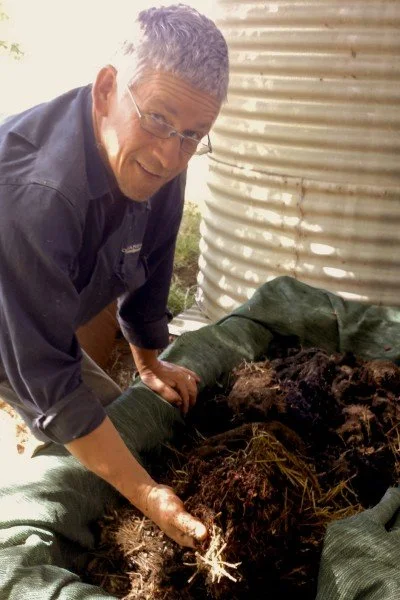Get a wriggle on with worm farming!
This week, Hugh Finlay from Grow Great Fruit and the Harcourt Organic Food Coop takes the Compost Conversation reigns and gives us a run down on the ins and outs of worm farming.
The purpose of a worm farm is to turn kitchen and garden waste into fabulously rich fertiliser. Worms like dark, cool, and moist (but not wet) conditions. They need regular feeding, and protection from predators, especially birds (including chooks!).
This may sound like they are high maintenance, but in fact worm farms are easy to manage once you get the hang of it, and the end product of free fertiliser makes it all worthwhile. If you are only going to do one thing for your garden, use ‘worm castings’!
Worm farming can be as simple or complicated as you like. In-ground feeding is worm farming at its most basic. You simply bury worm food (usually kitchen scraps) at different spots in the garden, and the (earth) worms will come and find it. This system is ideal for the “hands-off” worm famer—it requires very little maintenance and does not rely on you doing anything other than supplying food.
Worm ‘towers’ are a step up from in-ground feeding. In this system a container or tub, with a mesh bottom or lots of holes in the base and/or sides is part-buried in the garden. Food scraps are added to the container and the worms come and go at their leisure. Worm towers are easy to make out of a short length (~50 cm) of wide (say, 150 mm or more) PVC pipe with holes drilled in it.
Readymade worm farms, usually plastic, are widely available from garden centres and online. The most common type consists of a series of 2–4 trays that fit one on top of each other. The base tray is usually solid and is where the liquid (often called ‘worm juice’) collects. The other trays have a mesh bottom so the worms can move between them.
If you’re happy to get your hands dirty, a build-your-own worm farm is the way to go. in any old container. The beauty of building your own is that you can do it to the scale you want and it generally costs next to nothing as you can use all manner of containers—polystyrene vegie box or boxes, old drawers, a bathtub, an old fridge, or a wheelie bin are some possibilities. The main thing is to ensure that water can drain from your container or your worms will drown. Place a few cm of bedding material in the bottom, and a couple of handfuls of soil (the grit aids the worms’ digestion). Add compost worms!
The main trick with worm farms is not to overfeed your wriggly friends, and to keep their home moist but not sopping wet. They’ll eat pretty much anything that was once alive— even hair and vacuum cleaner dust—although the softer and finer the better. Like us, worms benefit from variety in their diet, but are happier if certain foods such as onions, garlic, and citrus are added only in small amounts.
AUTHOR: HUGH FINLAY
Hugh Finlay is a friend and supporter of *Yes In My Back Yard, (YIMBY), a community-scale composting initiative in Castlemaine and surrounds. Send questions or comments to hello@yimbycompost.com or to book in for a compost workshop!
This was first published in the Midland Express on 9 August 2024

